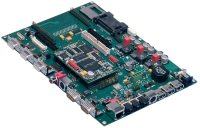Austrian SBC vendor touts single-kernel real-time Linux
Dec 6, 2005 — by LinuxDevices Staff — from the LinuxDevices Archive — 6 views [Updated Dec. 13] — An Austrian single-board computer and real-time OS vendor has created a single-kernel, real-time Linux implementation for a small ARM9-based CPU module. Contec says its Micro-9 CPU module can now deliver real-time performance without requiring dual kernels or requiring programmers to use… non-standard APIs.
[Updated Dec. 13] — An Austrian single-board computer and real-time OS vendor has created a single-kernel, real-time Linux implementation for a small ARM9-based CPU module. Contec says its Micro-9 CPU module can now deliver real-time performance without requiring dual kernels or requiring programmers to use… non-standard APIs.
(Click for larger view of Contec Micro-9 CPU module)
According to technical marketing manager Ashley Robert Calpin, the Contec real-time Linux implementation is based on a 2.6.14-rc5-rt7 Linux kernel. It is built with pre-emptive patches, NPTL (native POSIX thread library) for ARM-CPUs, generic interrupt handling for ARM-CPUs, high-resolution timers, and fast user-space mutexes.
Calpin said, “By converting Interrupt Service Routines (ISR) in prioritized threads, and consequently minimizing the 'non pre-emptive' areas of the Linux kernel, the implementation of a double kernel as well as a separate program interface (API) is no longer necessary.”
Calpin adds, “Our real-time Linux adaptation was developed with the aid and support of the community, with [which] our Engineers cooperate continually.”
By “double kernel,” Calpin is referring to alternatives such as RTLinux and RTAI.
Calpin adds that existing real-time and other applications can be easily ported to the environment, thanks to POSIX compatibility, with “minimal modifications into the real-time context.”
Contec says it has developed a test environment aimed at thoroughly exercising the functionality of its real-time Linux implementation. The test environment can measure interrupt latency and “periodical tasks” latency, as well as “runtime evaluation of signals.”
The Micro-9 CPU module
 |
for Micro-9 (Click to enlarge) |
The Contec real-time Linux implementation currently supports the company's “Micro-9” board, a creditcard-sized CPU module based on a 200MHz ARM9 processor with an integrated graphics coprocessor. The Micro-9 measures 2.1 x 3.3 inches (54 x 85mm), yet provides a full range of PC connectivity. Features include:
- CPU
- 200MHz ARM9 processor
- Integral graphics coprocessor
- Memory
- 32MB RAM (64/128 optionally avail.)
- 1MB battery-backed SRAM
- 32MB NOR Flash (64MB optionally avail.)
- 4KB of EEPROM
- Display
- 1280 x 1024 LCD/TFT
- 4-, 5-, 7-, or 8-wire touchscreen
- I/O
- 1 x 10/100 Ethernet
- Three USB 2.0 host ports
- Three serial interfaces
- AC 97 Audio codec
- 8- and 16-bit PCMCIA interface
- CAN bus controller
- SPI (serial packet interface) controller
- Two high-density debugging ports
- 2-channel (master/slave) EIDE/CF ports
- JTAG debugging/programming port
- Other
- Watchdog with 1.6 second timeout
- Battery-backed RTC (real-time clock) with alarm interrupt
- Power failure detection
- Operating systems
- Linux
- Real-time Linux
- Windows CE
Availability
The Micro-9 CPU module is available now with real-time Linux. Additionally, Contec says it will demonstrate its real-time Linux adaptation running on a variety of modules at Embedded World 2006, set for Nuremberg, Germany, on Feb. 14-16.
Note: This story originally described Contec's implementation as “proprietary” due to a Contec marketing department error in translating a German word meaning “in-house,” according to Contec. The story was corrected on Dec. 13.
This article was originally published on LinuxDevices.com and has been donated to the open source community by QuinStreet Inc. Please visit LinuxToday.com for up-to-date news and articles about Linux and open source.